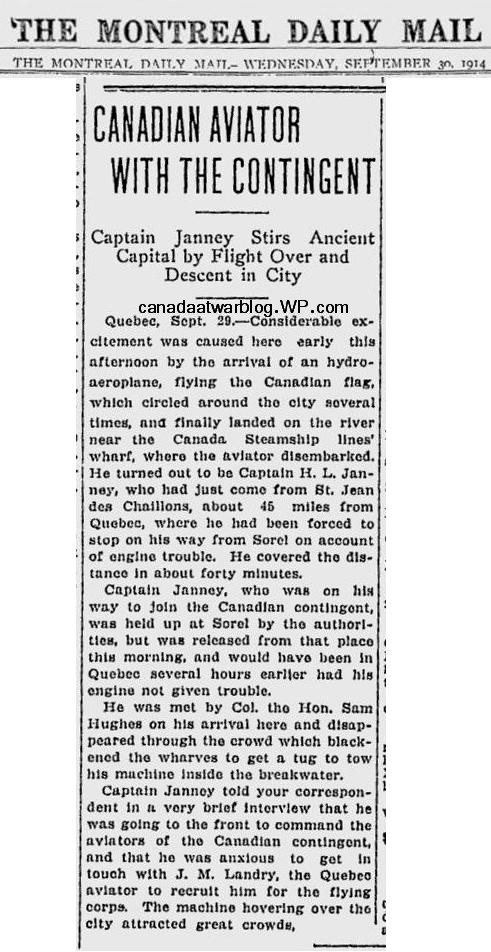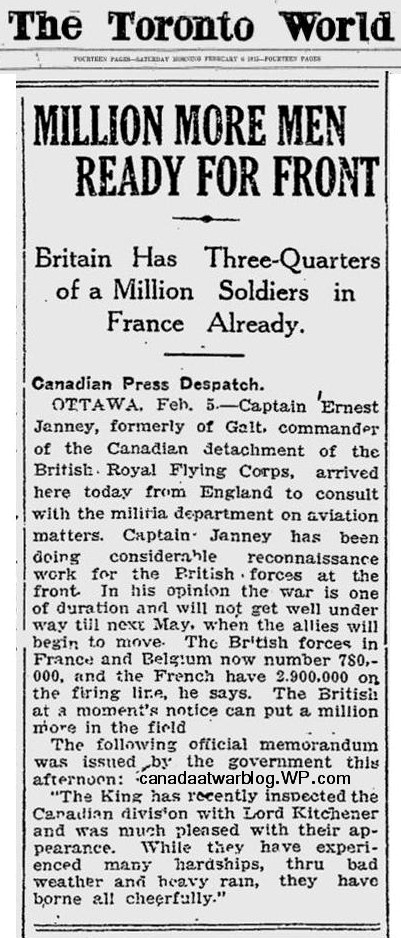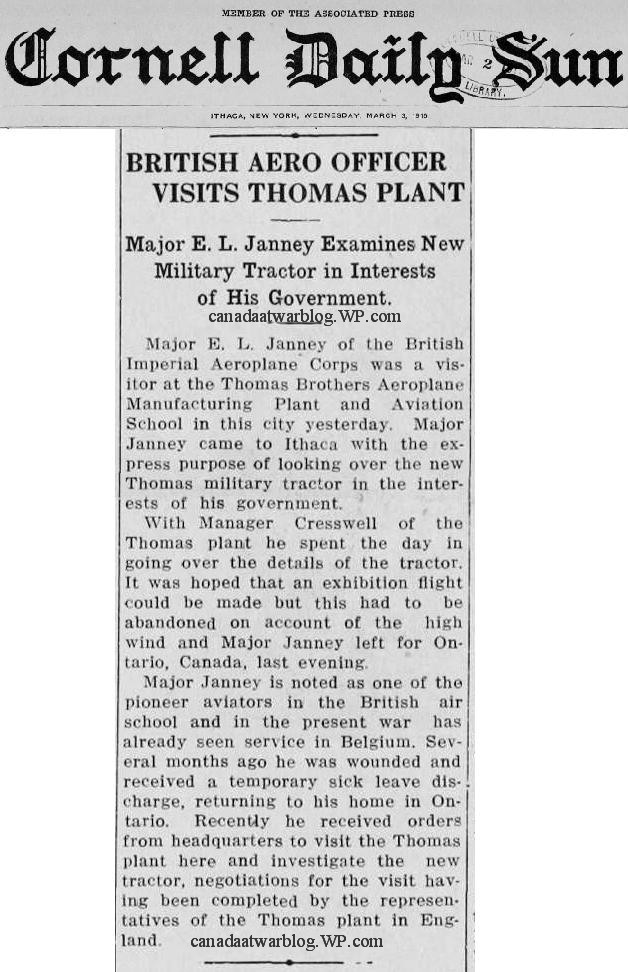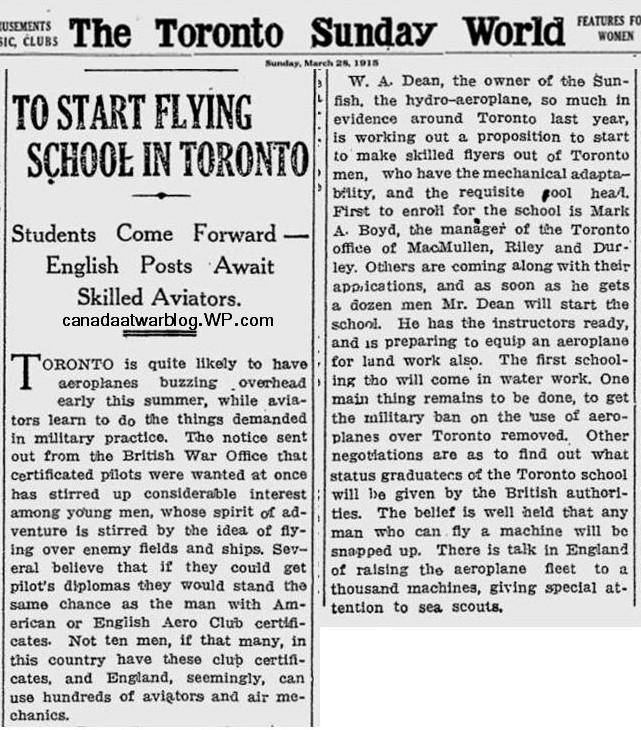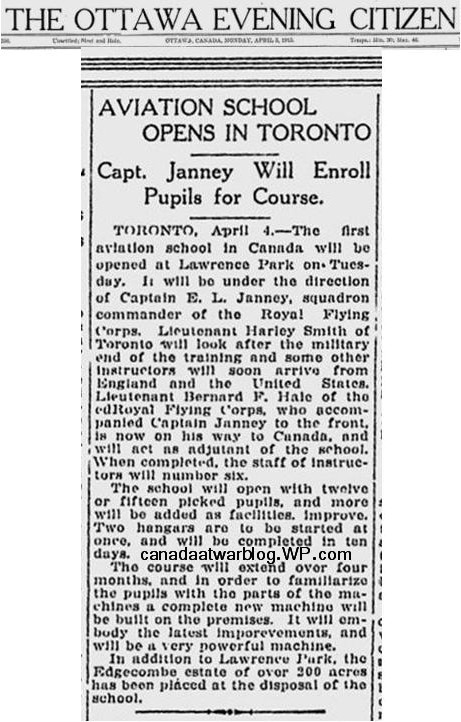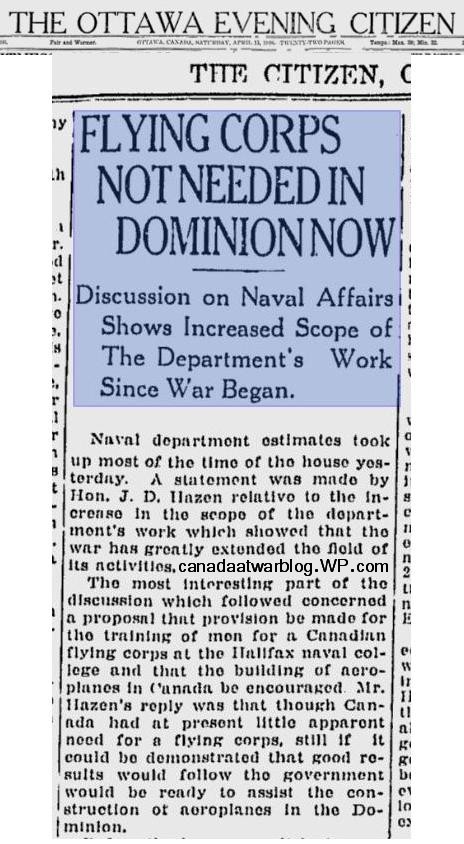- Reaction score
- 0
- Points
- 210
P.B.A., the below are snippets deriving from a first draft study-paper; those requiring a comprehensive account with more newspaper clippings of the day, fallow short link: http://wp.me/p55eja-K8
S.V.P.: The below fallows Janney, etc., from 1914-19, while part II still not published, is completed, a newspaper timeline covering 1920-30s.
Canada’s National Defence Directorate of History and Heritage (DHH) founded in 1996, following the amalgamation of the National Defence History Directorate and the Directorate of Military Traditions and Heritage. The roots of our organization go all the way back to the First World War. Section 2 of (DHH), namely DHH 2, is responsible for fulfilling its primary role of researching and writing official histories of the Canadian Forces and Department of National Defence. In addition to producing official histories, DHH 2 is tasked from time to time with the research and writing of commemorative histories to mark significant milestones in Canadian military history and other historical studies which will be useful to official historians in the future. Mandated to preserve and communicate Canada’s military history and foster pride in Canadian military heritage.
DHH 2, 1938 narrative compared too 1962 – 64, omitting vital information, embellishing the account as fallows: —
DHH 2, OH The Canadian Forces In The Great War 1914-19 Vol. I. 1938. The First Contingent At Valcartier Camp: Chapter II p.69 as fallows: —
Two other special units associated with the Contingent must also be mentioned here—not because of their strength, as their combined total personnel never exceeded ten, but because both were innovations in the Canadian forces. The first of these, although not regularly established by orders, may be considered as the forerunner of a larger organization which came into being later. In August the Minister had offered to send six aviators with the Contingent, and Lord Kitchener had agreed; early in September the Minister accepted the services of two Ontario-born aviators, “understood to be accomplished and experienced,” and one of them was “appointed provisional Commander of the Canadian Aviation Corps”; but the number remained at two, and the corps itself was not authorized. Although never attested in the C.E.F., the two aviators proceeded to England with the Contingent to qualify for the Royal Flying Corps. Their equipment consisted of “one Burgess-Dunne biplane,” flown from the factory at Marblehead, Mass., to Valcartier, and then crated to England, but never again assembled. Of the two aviators one returned to civil life in Canada, January 1915; the other, Lieut. W.F. Sharpe, after undergoing instructional flying in France—the first Canadian aviator to fly there—was killed on 4th February 1915, on his first solo flight in England while attached to the R.F.C.
DHH 2, OH CEF FWW 1914-19, 1964: — (There was no air force; in 1909, the year of the first aeroplane flight in Canada, the Militia Council had witnessed demonstration flights at Petawawa, but a very limited Canadian military flying service was not organised until after war broke out)……….. On 25 August 1914 Colonel Sam Hughes cabled Lord Kitchener an offered to send aviators with the First Contingent. Kitchener asked for six, but only two could be provided. They were organized into a short-lived provisional “Canadian Aviation Corps” at Valcartier, and with one aeroplane, purchased in the United States, they accompanied the First Contingent to England. One aviator almost immediately returned to civil life in Canada. The other, Lieutenant W.F. Sharpe, underwent instructional training in France, but was killed on 4 February 1915 while making his first solo flight in England. Their American aircraft never left the ground.
Considering both narratives if C.A.C. was not authorised, and its members attested like C.E.F., no one could be appointed provisional Commander with a Captain’s commission, in a Canadian ‘provisional’ phantom aviation corps. Document of provisional unites listed, a flying corps is nonexistent in the first place; “the two aviators proceeded to England with the Contingent to qualify for the Royal Flying Corps.” True; on S.S. Athenia ships manifest she transported the hydroplane, while the S.S. Franconia including “two aviators and one mechanic” aboard, not as a flying unit, “attached to the headquarter staff.” Therefore the latter implies, C.-in-C., “Uncle Sam” Hughes’ after offering six, only mustered two, showing good form contributed the hydroplane, after being manipulated by Janney. “Lord Kitchener had agreed; early in September accepted the services of two aviators, to qualify for the RFC,” while Hughes’ bluntly advises Alderson: “Janney and Sharpe were sent to join the Royal Flying Corps,” “not intended to organise a flight unit.” Outspoken Hughes, in official bio, 1914-15 documents, press, etc., personally never mentions, he authorised CAC and made one aviator or Janney its provisional commander with the rank of Captain, nor will documents etc., ever surface.
Owing to DHH 2, misleading, hazy, and vague accounts, “fostering pride in Canadian military heritage,” the questions too ask:—
1. What year was Canada’s first authorised Air Corps, Sept. 1914, or Sept. 1918?
2. Was the CAC, an officially authorised unit, and where’s the Documents’ supporting the facts?
3. In the Sessional Paper 40, etc., CAC are not recorded, All, provisional contributions and “special units” are?
4. Janney & Sharpe, “understood to be accomplished and experienced aviators,” by hum?
5. The hydroplane was $5000, or $7500usf., + expenses, a portion pocketed by Janney?
6. Landing at Sorel for fuel, Janney and C. Webster are arrested by Canada Customs?
7. The BD-1B biplane delayed by the arrest, and engine problems for 7 days?
8. Accounts claim delayed 3 days for repairs, Québec City is 1hr by air?
9. Date the biplane arrived and landed on St. Lawrence River at Québec City docks?
10. The status quo account on the biplane being disassembled, crated, loaded on the ship?
11. Time, date SS Athenia left dock drifted and anchored, Master received sealed orders?
12. While at Gaspe Bay, when was the SS Athenia authorised to set steam for Plymouth?
13. Mainstream misleading recycled account, CAC boarded and set sail on SS Athenia?
14. Halliday: Did Hughes forget, given up on it, or Kitchener approves aviators for RFC?
15. “Uncle Sam” Hughes’ advises Alderson: “Janney and Sharpe, were sent to join the Royal Flying Corps,” with no military rank or pay?
16. D.M.D. cables Alderson, “Janney and Sharpe not intended to organise a flight unit”?
17.The folklore surrounding CAC, originates from Janney while in England and Canada?
18. C.A.C. or C. Flying C. was a generic name used by press, etc., from 1915 – 1917?
19. The name CAC first surfaces in The Globe, Tue., Dec., 1, 1914, pg. 9, col. 1?
20. The Globe:–‘A Canadian aviation corps,’ is being organized at Salisbury Plain, and will be attached to the Canadian army when it leaves for the front?
21. Goes MIA on two separate occasions while at Salisbury Plain, totalling ca 6 weeks?
22. Janney’s sous-fonds, etc., cost $116,679.25 the commander states $120,000?
23. Lt.-Gen. E.A.H. Alderson, foiled Janney’s self appointed rank and deceptive, scheme?
24. Uniformed as a British major, aviator, while in England, America and Canada?
25. DHH 2, CEF OH 1938-64; “and one of them was appointed provisional Commander of the Canadian Aviation Corps.” (Why is Janney not mentioned, Lieut. W. F. Sharpe is)?
26. The year Janney’s Canadian Aviation Corps (CAC), historian/author narrative surfaces?
27. Underhanded Janney, foresaw financial gains during the roots of Canadian aviation?
28. Lt.-Col. Cull arranged Janney’s sub-lieut., commission in the Royal Canadian Naval Volunteer Reserve?
29. The Canadian flying corps seeds are rooted with the Royal Flying Corps, Canada, Dec., 1916, though officially an Imperial unit?
30. E.L. Janney insured his legacy as a Canadian military pioneer in aviation history?
With way too many questions up for grabs in the Janney, CAC saga, I’ll add just one more: —
If ‘Canadian Aviation Corps’ was raised, authorised, organised in Valcartier Camp, while at Salisbury Plain, Janney claims the ‘Canadian Flying Corps’ was not yet established, on May 1915 to a correspondent.
The narrative on Canada’s aviation corps first bearings, are located all over the map, at times cloudy and misleading, depending on historian/author accounts, throughout past decades in historical literature. According too mainstream recycled narrative on Canada’s roots of an Air Force, the majority, 75% claim, extend to the Canadian Aviation Corps (CAC) 1914-15, “humble beginnings.” True, there’s scholars, academies, etc., fully aware of this fiasco in Canadian F.W.W. accounts, critically scrutinising the veracity of C.A.C.’s formation and Janney’s appointment by Hughes. The narrative of a “Canadian aviation corps” surfaced with Janney using the press, on 1st Dec., 1914 and supposedly 2nd Feb., 1915, according to Holliday. However on the morning of 29th Sept., 1914 on his return at Quebec City on the wharf in a brief interview too reporters without Hughes’ present: “I’m going to the front to command the aviators of the Canadian contingent,” further adding, “he’s anxious to recruit Quebec aviator J.M. Landry for the flying corps,” no mention of CAC………………
Considering Janney’s name was dismissed, while Lt. Sharpe is mentioned, DHH 2 accounts for 1938 are not sourced, nor documents supporting the CAC narrative, is problematic and certainly questionable. Furthermore, DHH 2 OH 1962 and 1964 sources: — Duguid, I, 73. General H.D.G. Crerar to author, 26 Jan 62, HQC 1456-1-3. Janney died in 1941, the Queens University Archives on Subfonds SF71 - creator Janney, Ernest Lloyd, 1929-30 (Creation), championed CAC., and Captain Janney. Unless there’re others that I’m not aware, Roberts, Leslie (1959): There Shall Be Wings is the earliest historian/author account I read. “A Burgess-Dunne plane was purchased in the United States, shipped to Vermont and then flown to Valcartier Quebec, where it was taken apart, crated, and shipped to England. p. 7.” I’m personally aware books were published post FWW on Canadian aviators serving with the RNAS and RFC, plausible there could be earlier accounts. From early 1950s and 60s the formation of CAC was printed by the Canadian press, an introduction to “Canada’s First Military Aircraft.” The press in the 50s narrated DHH 2, OH FWW 1938 account, by the 60s DHH 2, 1962-64 account was used, in both, including Lt. Sharpe’s death and omitting Janney’s name. Considering Aviation In Canada 1917-18, by Alan Sullivan. Lt., R.A.F., published in 1919, makes no mention. Noted in: “A History Of Canadian Naval Aviation 1918-1962,” published in 1965, p.6.: “In October 1918 part of the third contingent committee, consisting of Major Stewart, Captain Barron, Lieutenant Cameron, CEF, and Sub-Lieutenant E.L. Janney, RNCVR, set up shop in Regina to make a selection from the western applicants recruiting for the R.C.N.A.S.
In late 1990s written by Don Nicks a series of articles for North Bay and Moose Jaw base newspapers, covering CAC and Janney’s exploits. Nicks’ article certainly questionable, “Capt Janney flew the aircraft back to Canada, the aircraft was crated for shipping, and the CAC sailed on.” In Sorel, Quebec, Canada Customs detained both, impounding the biplane, later both were released; is a factual account. Legion Magazine: — July 1, 2004 by Hugh A. Halliday, Air Force, Part 4: — “A High Flyer, Indeed,” was published, and considered the benchmark on Capt. E.L. Janney’s CAC saga. It’s a shame on sourcing newspapers avoiding interoperation issues, the complete original columns are not provided, just author’s snippets. Per say: “On Feb. 3, 1915, the Halifax Morning Chronicle, under the headline Canadian Air Man Returns From The Front. Mentions CAC, omitted all references to Sharpe and Farr.” Holliday states’ printed by other Canadian press, conducted a comprehensive search and still looking, considering CAC was used by The Globe 1st Dec., 1914, seriously question if Janney styled it as Canadian Aviation Corps. The afternoon, 29th Sept., 1914 on the wharf while being questioned by a correspondent, makes no mention of a flying unit formation styled as CAC. However Janney reported at Québec City docks, “going to the front to command the aviators of the Canadian contingent.” On 5th Feb., 1915, aviator squadron commander in the Canadian detachment, of the of the British Royal Flying Corps, by the 2nd Mar., Janney stated he served with the British Imperial Aeroplane Corps in Belgium, while on 1st April, his anecdote changes; served with the Royal Flying Corps and by May: When the contingent arrived at Salisbury Plain the officer (Janney) was still attached to headquarters. He, according to himself, was to be in command of the ‘Canadian flying corps’ which was about to be established.
C.-in-C., Lt.-Col. Samuel Hughes’ although critical of militia aviation August 1914: — “Aviation is of no value in war, I do not propose to tie the government up financially to such a ridiculous scheme.” Surprisingly offered aviators to the “Secretary of State for War,” Lord Kitchener 25th Aug., 1914, responded on the 31st, Britannia would accept 6 experienced aviators at the present, with more too follow if needed. Hughes attempts proved fruitless, as only a few applicants were interested, sadly fell short on British requirements. Mustered a mire two individuals, although one was a licensed aviator, the other was a “chin-wagging high flyer.” Furthermore, “did approve, (Hughes) the formation of a small unit accompany the Canadian Expeditionary Force to England,” is not factual. Accounts state, the CAC was authorised on 16th Sept. 1914, consisting of two pilots and one mechanic, while the aeroplane needed to be purchased. Ernest Lloyd Janney, born 16th Jun, 1893, Galt, Ontario, laboured as a motor mechanic operating a garage, incomprehensively was picked. William F.N. Sharpe of Prescott, Ontario, travel to Californian by 1913 instructed by Glenn H. Curtiss as an aviator, and accomplished his schooling. Sharpe was a certified aviator by January 1914, prior to the outbreak of war only four Canadians were licensed, by the Aero Club of America as ‘pilots.’ Harry A. Farr of West Vancouver, British Columbia was chosen as the biplane mechanic; “understood to be accomplished and experienced.” The RCAF Museum, DHH, etc., status quo narrative: E.L. Janney, (at the time 21 years old) or one was appointed “Provisional Commander,” commissioned the rank of Captain, authorised to spend not more then $5,000 for an aeroplane. “Capt. Janney acquired a biplane from the Burgess-Dunne Company in Massachusetts, delivered to Quebec City, arriving on 30th Sept., or 1st Oct.,” according too accounts. Hastily loaded onboard SS Athenia and crated, CAC sailed over the pond…………
S.V.P.: The below fallows Janney, etc., from 1914-19, while part II still not published, is completed, a newspaper timeline covering 1920-30s.
Canada’s National Defence Directorate of History and Heritage (DHH) founded in 1996, following the amalgamation of the National Defence History Directorate and the Directorate of Military Traditions and Heritage. The roots of our organization go all the way back to the First World War. Section 2 of (DHH), namely DHH 2, is responsible for fulfilling its primary role of researching and writing official histories of the Canadian Forces and Department of National Defence. In addition to producing official histories, DHH 2 is tasked from time to time with the research and writing of commemorative histories to mark significant milestones in Canadian military history and other historical studies which will be useful to official historians in the future. Mandated to preserve and communicate Canada’s military history and foster pride in Canadian military heritage.
DHH 2, 1938 narrative compared too 1962 – 64, omitting vital information, embellishing the account as fallows: —
DHH 2, OH The Canadian Forces In The Great War 1914-19 Vol. I. 1938. The First Contingent At Valcartier Camp: Chapter II p.69 as fallows: —
Two other special units associated with the Contingent must also be mentioned here—not because of their strength, as their combined total personnel never exceeded ten, but because both were innovations in the Canadian forces. The first of these, although not regularly established by orders, may be considered as the forerunner of a larger organization which came into being later. In August the Minister had offered to send six aviators with the Contingent, and Lord Kitchener had agreed; early in September the Minister accepted the services of two Ontario-born aviators, “understood to be accomplished and experienced,” and one of them was “appointed provisional Commander of the Canadian Aviation Corps”; but the number remained at two, and the corps itself was not authorized. Although never attested in the C.E.F., the two aviators proceeded to England with the Contingent to qualify for the Royal Flying Corps. Their equipment consisted of “one Burgess-Dunne biplane,” flown from the factory at Marblehead, Mass., to Valcartier, and then crated to England, but never again assembled. Of the two aviators one returned to civil life in Canada, January 1915; the other, Lieut. W.F. Sharpe, after undergoing instructional flying in France—the first Canadian aviator to fly there—was killed on 4th February 1915, on his first solo flight in England while attached to the R.F.C.
DHH 2, OH CEF FWW 1914-19, 1964: — (There was no air force; in 1909, the year of the first aeroplane flight in Canada, the Militia Council had witnessed demonstration flights at Petawawa, but a very limited Canadian military flying service was not organised until after war broke out)……….. On 25 August 1914 Colonel Sam Hughes cabled Lord Kitchener an offered to send aviators with the First Contingent. Kitchener asked for six, but only two could be provided. They were organized into a short-lived provisional “Canadian Aviation Corps” at Valcartier, and with one aeroplane, purchased in the United States, they accompanied the First Contingent to England. One aviator almost immediately returned to civil life in Canada. The other, Lieutenant W.F. Sharpe, underwent instructional training in France, but was killed on 4 February 1915 while making his first solo flight in England. Their American aircraft never left the ground.
Considering both narratives if C.A.C. was not authorised, and its members attested like C.E.F., no one could be appointed provisional Commander with a Captain’s commission, in a Canadian ‘provisional’ phantom aviation corps. Document of provisional unites listed, a flying corps is nonexistent in the first place; “the two aviators proceeded to England with the Contingent to qualify for the Royal Flying Corps.” True; on S.S. Athenia ships manifest she transported the hydroplane, while the S.S. Franconia including “two aviators and one mechanic” aboard, not as a flying unit, “attached to the headquarter staff.” Therefore the latter implies, C.-in-C., “Uncle Sam” Hughes’ after offering six, only mustered two, showing good form contributed the hydroplane, after being manipulated by Janney. “Lord Kitchener had agreed; early in September accepted the services of two aviators, to qualify for the RFC,” while Hughes’ bluntly advises Alderson: “Janney and Sharpe were sent to join the Royal Flying Corps,” “not intended to organise a flight unit.” Outspoken Hughes, in official bio, 1914-15 documents, press, etc., personally never mentions, he authorised CAC and made one aviator or Janney its provisional commander with the rank of Captain, nor will documents etc., ever surface.
Owing to DHH 2, misleading, hazy, and vague accounts, “fostering pride in Canadian military heritage,” the questions too ask:—
1. What year was Canada’s first authorised Air Corps, Sept. 1914, or Sept. 1918?
2. Was the CAC, an officially authorised unit, and where’s the Documents’ supporting the facts?
3. In the Sessional Paper 40, etc., CAC are not recorded, All, provisional contributions and “special units” are?
4. Janney & Sharpe, “understood to be accomplished and experienced aviators,” by hum?
5. The hydroplane was $5000, or $7500usf., + expenses, a portion pocketed by Janney?
6. Landing at Sorel for fuel, Janney and C. Webster are arrested by Canada Customs?
7. The BD-1B biplane delayed by the arrest, and engine problems for 7 days?
8. Accounts claim delayed 3 days for repairs, Québec City is 1hr by air?
9. Date the biplane arrived and landed on St. Lawrence River at Québec City docks?
10. The status quo account on the biplane being disassembled, crated, loaded on the ship?
11. Time, date SS Athenia left dock drifted and anchored, Master received sealed orders?
12. While at Gaspe Bay, when was the SS Athenia authorised to set steam for Plymouth?
13. Mainstream misleading recycled account, CAC boarded and set sail on SS Athenia?
14. Halliday: Did Hughes forget, given up on it, or Kitchener approves aviators for RFC?
15. “Uncle Sam” Hughes’ advises Alderson: “Janney and Sharpe, were sent to join the Royal Flying Corps,” with no military rank or pay?
16. D.M.D. cables Alderson, “Janney and Sharpe not intended to organise a flight unit”?
17.The folklore surrounding CAC, originates from Janney while in England and Canada?
18. C.A.C. or C. Flying C. was a generic name used by press, etc., from 1915 – 1917?
19. The name CAC first surfaces in The Globe, Tue., Dec., 1, 1914, pg. 9, col. 1?
20. The Globe:–‘A Canadian aviation corps,’ is being organized at Salisbury Plain, and will be attached to the Canadian army when it leaves for the front?
21. Goes MIA on two separate occasions while at Salisbury Plain, totalling ca 6 weeks?
22. Janney’s sous-fonds, etc., cost $116,679.25 the commander states $120,000?
23. Lt.-Gen. E.A.H. Alderson, foiled Janney’s self appointed rank and deceptive, scheme?
24. Uniformed as a British major, aviator, while in England, America and Canada?
25. DHH 2, CEF OH 1938-64; “and one of them was appointed provisional Commander of the Canadian Aviation Corps.” (Why is Janney not mentioned, Lieut. W. F. Sharpe is)?
26. The year Janney’s Canadian Aviation Corps (CAC), historian/author narrative surfaces?
27. Underhanded Janney, foresaw financial gains during the roots of Canadian aviation?
28. Lt.-Col. Cull arranged Janney’s sub-lieut., commission in the Royal Canadian Naval Volunteer Reserve?
29. The Canadian flying corps seeds are rooted with the Royal Flying Corps, Canada, Dec., 1916, though officially an Imperial unit?
30. E.L. Janney insured his legacy as a Canadian military pioneer in aviation history?
With way too many questions up for grabs in the Janney, CAC saga, I’ll add just one more: —
If ‘Canadian Aviation Corps’ was raised, authorised, organised in Valcartier Camp, while at Salisbury Plain, Janney claims the ‘Canadian Flying Corps’ was not yet established, on May 1915 to a correspondent.
The narrative on Canada’s aviation corps first bearings, are located all over the map, at times cloudy and misleading, depending on historian/author accounts, throughout past decades in historical literature. According too mainstream recycled narrative on Canada’s roots of an Air Force, the majority, 75% claim, extend to the Canadian Aviation Corps (CAC) 1914-15, “humble beginnings.” True, there’s scholars, academies, etc., fully aware of this fiasco in Canadian F.W.W. accounts, critically scrutinising the veracity of C.A.C.’s formation and Janney’s appointment by Hughes. The narrative of a “Canadian aviation corps” surfaced with Janney using the press, on 1st Dec., 1914 and supposedly 2nd Feb., 1915, according to Holliday. However on the morning of 29th Sept., 1914 on his return at Quebec City on the wharf in a brief interview too reporters without Hughes’ present: “I’m going to the front to command the aviators of the Canadian contingent,” further adding, “he’s anxious to recruit Quebec aviator J.M. Landry for the flying corps,” no mention of CAC………………
Considering Janney’s name was dismissed, while Lt. Sharpe is mentioned, DHH 2 accounts for 1938 are not sourced, nor documents supporting the CAC narrative, is problematic and certainly questionable. Furthermore, DHH 2 OH 1962 and 1964 sources: — Duguid, I, 73. General H.D.G. Crerar to author, 26 Jan 62, HQC 1456-1-3. Janney died in 1941, the Queens University Archives on Subfonds SF71 - creator Janney, Ernest Lloyd, 1929-30 (Creation), championed CAC., and Captain Janney. Unless there’re others that I’m not aware, Roberts, Leslie (1959): There Shall Be Wings is the earliest historian/author account I read. “A Burgess-Dunne plane was purchased in the United States, shipped to Vermont and then flown to Valcartier Quebec, where it was taken apart, crated, and shipped to England. p. 7.” I’m personally aware books were published post FWW on Canadian aviators serving with the RNAS and RFC, plausible there could be earlier accounts. From early 1950s and 60s the formation of CAC was printed by the Canadian press, an introduction to “Canada’s First Military Aircraft.” The press in the 50s narrated DHH 2, OH FWW 1938 account, by the 60s DHH 2, 1962-64 account was used, in both, including Lt. Sharpe’s death and omitting Janney’s name. Considering Aviation In Canada 1917-18, by Alan Sullivan. Lt., R.A.F., published in 1919, makes no mention. Noted in: “A History Of Canadian Naval Aviation 1918-1962,” published in 1965, p.6.: “In October 1918 part of the third contingent committee, consisting of Major Stewart, Captain Barron, Lieutenant Cameron, CEF, and Sub-Lieutenant E.L. Janney, RNCVR, set up shop in Regina to make a selection from the western applicants recruiting for the R.C.N.A.S.
In late 1990s written by Don Nicks a series of articles for North Bay and Moose Jaw base newspapers, covering CAC and Janney’s exploits. Nicks’ article certainly questionable, “Capt Janney flew the aircraft back to Canada, the aircraft was crated for shipping, and the CAC sailed on.” In Sorel, Quebec, Canada Customs detained both, impounding the biplane, later both were released; is a factual account. Legion Magazine: — July 1, 2004 by Hugh A. Halliday, Air Force, Part 4: — “A High Flyer, Indeed,” was published, and considered the benchmark on Capt. E.L. Janney’s CAC saga. It’s a shame on sourcing newspapers avoiding interoperation issues, the complete original columns are not provided, just author’s snippets. Per say: “On Feb. 3, 1915, the Halifax Morning Chronicle, under the headline Canadian Air Man Returns From The Front. Mentions CAC, omitted all references to Sharpe and Farr.” Holliday states’ printed by other Canadian press, conducted a comprehensive search and still looking, considering CAC was used by The Globe 1st Dec., 1914, seriously question if Janney styled it as Canadian Aviation Corps. The afternoon, 29th Sept., 1914 on the wharf while being questioned by a correspondent, makes no mention of a flying unit formation styled as CAC. However Janney reported at Québec City docks, “going to the front to command the aviators of the Canadian contingent.” On 5th Feb., 1915, aviator squadron commander in the Canadian detachment, of the of the British Royal Flying Corps, by the 2nd Mar., Janney stated he served with the British Imperial Aeroplane Corps in Belgium, while on 1st April, his anecdote changes; served with the Royal Flying Corps and by May: When the contingent arrived at Salisbury Plain the officer (Janney) was still attached to headquarters. He, according to himself, was to be in command of the ‘Canadian flying corps’ which was about to be established.
C.-in-C., Lt.-Col. Samuel Hughes’ although critical of militia aviation August 1914: — “Aviation is of no value in war, I do not propose to tie the government up financially to such a ridiculous scheme.” Surprisingly offered aviators to the “Secretary of State for War,” Lord Kitchener 25th Aug., 1914, responded on the 31st, Britannia would accept 6 experienced aviators at the present, with more too follow if needed. Hughes attempts proved fruitless, as only a few applicants were interested, sadly fell short on British requirements. Mustered a mire two individuals, although one was a licensed aviator, the other was a “chin-wagging high flyer.” Furthermore, “did approve, (Hughes) the formation of a small unit accompany the Canadian Expeditionary Force to England,” is not factual. Accounts state, the CAC was authorised on 16th Sept. 1914, consisting of two pilots and one mechanic, while the aeroplane needed to be purchased. Ernest Lloyd Janney, born 16th Jun, 1893, Galt, Ontario, laboured as a motor mechanic operating a garage, incomprehensively was picked. William F.N. Sharpe of Prescott, Ontario, travel to Californian by 1913 instructed by Glenn H. Curtiss as an aviator, and accomplished his schooling. Sharpe was a certified aviator by January 1914, prior to the outbreak of war only four Canadians were licensed, by the Aero Club of America as ‘pilots.’ Harry A. Farr of West Vancouver, British Columbia was chosen as the biplane mechanic; “understood to be accomplished and experienced.” The RCAF Museum, DHH, etc., status quo narrative: E.L. Janney, (at the time 21 years old) or one was appointed “Provisional Commander,” commissioned the rank of Captain, authorised to spend not more then $5,000 for an aeroplane. “Capt. Janney acquired a biplane from the Burgess-Dunne Company in Massachusetts, delivered to Quebec City, arriving on 30th Sept., or 1st Oct.,” according too accounts. Hastily loaded onboard SS Athenia and crated, CAC sailed over the pond…………



